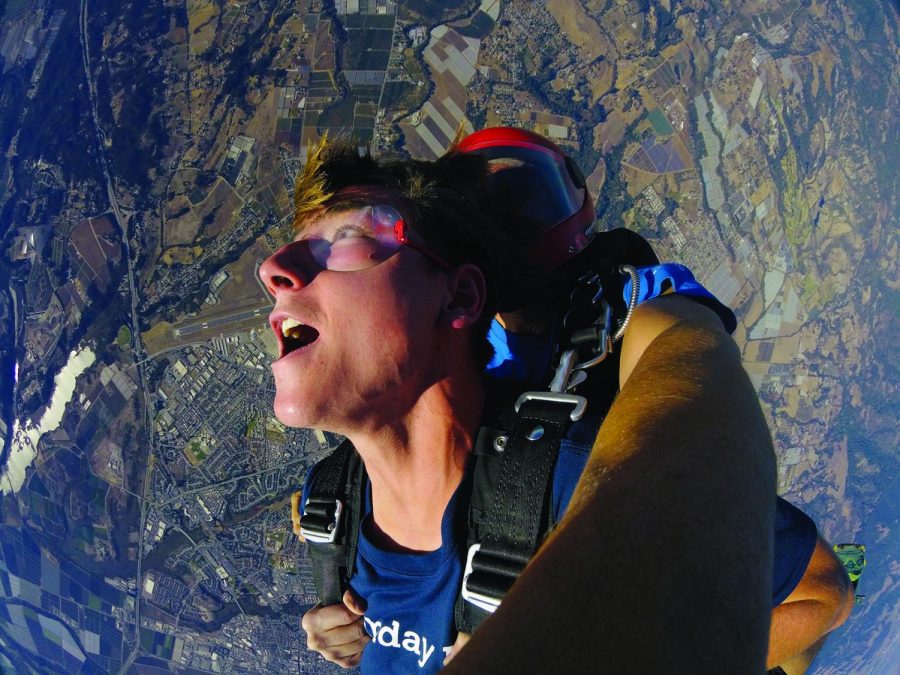To the Extreme
A look into the wild, crazy, and dangerous world of extreme sports
January 9, 2020
On October 12, 2014, Felix Baumgartner jumped from the edge of space.
“Sometimes, you have to be up really high, to understand how small you are,” he said with heavy breath as he looked over the vast Earth .
He was at the edge of the Earth’s stratosphere, so high that he could see the distinct curves of the blue planet we call home.
“I’m coming home now,” he said with a salute, as he leaned out of the capsule hovering more than 24 miles above the Earth’s surface. Then, he jumped.
His heart rate skyrocketed. 170, 180, 190 bpm. He accelerated to faster than the speed of sound, becoming the first person to ever break the sound barrier. He maxed out at 847 mph.
Then, he fell into an uncontrollable spin. He was completely disoriented as he was in complete free-fall tens of thousands of feet above the Earth’s surface. If he hadn’t gone through intense preparation and training, he may have been unable to recover.
As he plummeted toward the Earth, he stabilized his descent, and after over 4 minutes of free-fall, he deployed his parachute and floated to the ground in the middle of a barren desert. He had done it. He had jumped from the edge of our atmosphere and broken the sound barrier. Now he was on solid ground.
When most of us think of sports, we think of football, basketball, soccer, or any other athletic activity we partake in on a regular basis. However, there is a whole other world of sports that pushes the boundaries of physical achievement and constantly redefines what is possible. In extreme sports, or physical activities characterized by a high level of physical risk, athletes risk their lives to do what many think is impossible. They are able to overcome great levels of fear and high risk in order to “send it” under some of the most extreme conditions.
However, the world of extreme sports goes far beyond the physical risk. Extreme sports require mental as well as physical strength that is often greater than the levels needed to thrive in traditional sports. Some have theorized the existence of underlying biological mechanisms that allow some extreme athletes to do what they do. The unique nature of extreme sports breeds an interesting and complex culture that many people who see extreme sports fail to see or understand. Extreme sports also have strong connections to the commercial world, and is an extremely intriguing industry.
When people think of extreme sports, they think of the high physical risk and dismiss the sport and its athletes as crazy and reckless. Though extreme sports are dangerous, they do not exist based on “death wishes” or stupidity. They exist because of an internal desire to not merely survive, but to live a full and exciting life. They believe that “living” is more important than being alive, and for these athletes “living” means getting that adrenaline rush. For extreme athletes, the rush they get from skiing down a rocky cliff or wingsuit-jumping off a mountain top overcomes any fear of harm. Extreme sports are based on desires to live, not death wishes.
Extreme sports, as said before, are physical activities characterized by high levels of physical risk, which can range from different types of skiing, to different types of rock climbing, to wingsuiting (squirrel suit flying), to skydiving, to countless other sports. One thing is the same: risk. But if they’re so risky, then why do people do them?
Despite the high levels of danger, people are often drawn to the adrenaline rush they get from pushing the boundaries of human achievement. Their desire for that rush often allows them to overcome their fears.
Paly student Ryan Bara (‘20) went skydiving for his 18th birthday. He was motivated by a need for the unparalleled stimulus that comes with a wave of adrenaline.
“I have always been a person who loves adrenaline…and that drew me to skydiving,” Bara said.
Bara was aware of the physical risks, but his desire for thrill allowed him to accept the danger and jump out of an airplane way up in the sky above the Earth.
This gives insight to part of the culture in extreme sports. Those who die or are injured doing extreme athletic feats are enshrined as legends who died doing the impossible, and though they are prime examples of the danger posed by extreme sports, these deaths do not generally discourage extreme athletes from continuing to risk their lives.
A prominent example of this occurred at a wingsuit proximity flying event—where people in squirrel suit flyers fly at high speeds in close proximity to rocks and trees—in 2013. One of the world’s best flyers, Mark Sutton, hit a cliff at 150 mph and died early in the event. Instead of cancelling the event and mourning his death, the remaining participants made a simple toast to his memory and went back out the next day.
His friends said that Mark lived his life pushing the boundaries of what was possible, and that if he were still alive he would want them to always keep flying. That is exactly what they did.
Many people overcome their fears by embracing a life of danger, such as these wingsuit flyers, or through their love of adrenaline, like Ryan Bara.
However, in some cases, those who continually participate are driven by underlying biological mechanisms. It is a biological anomaly that enabled one of the greatest athletic feats in history.
On June 3, 2017, in one of the greatest feats in the history of extreme sports, Alex Honnold free soloed El Capitan, becoming the first person to ever do so. He scaled the 900-foot vertical cliff in a few hours…with no ropes or safety equipment. Yes, you read that correctly. But what if he fell? Well, he would die, obviously. One false move…. At many moments, his life was hanging by his fingertips on ledges mere centimeters in width.
How could anyone ever do this? Turns out his brain is different from most people. His fear complex, the amygdala, requires more stimulus to activate than that of a normal person.
Because of his achievements in free solo climbing, such as scaling the face of Half Dome in Yosemite or the Moonlight Buttress in Utah, he underwent an FMRI Brain Scan. The researchers showed him pictures of stimulating scenes, like mutilated bodies, and asked him questions about whether or not he would like to participate in certain thrilling activities. The scientists then compared his results to those of a normal person. The findings were astounding.
Alex Honnold’s fear complex had almost no activity and on the control subjects, there were high levels of activity, indicating that he is significantly less risk averse than most. He was determined to be approximately twice as attention seeking as the average person and had values 20 percent higher than the average high attention seeker.
Honnold is able to hang by his fingertips hundreds of feet above the ground and keep his composure because he literally is not affected by fear in the same way that the average person is.
Another prominent aspect of the world of extreme sports is the commercial side of the industry. RedBull and GoPro sponsor many extreme athletes and extreme sports competitions, and the “send it” attitude, or willingness to do anything in the moment, surrounding these companies perpetuates the industry.
Felix Bumgartner’s jump from the stratosphere was an event organized by RedBull, and the company also sponsors mountain biking, freeskiing, and wingsuiting events. Companies like RedBull and GoPro, the latter of which equips all extreme athletes with first-person cameras, encourage athletes in their quest to do the impossible.
Many athletes are shown to be drinking RedBull at the top of mountains before they attempt any extreme athletic feat. GoPro videos are released online in order to promote events and expand the industry.
The extreme sports industry has been coming more and more into the public sphere, which is exemplified by the release of an extreme sports based video game in 2016 entitled Steep.
There is a strong sense of community among many groups of extreme athletes as they all share a common risk and are all driven by the same thrill-loving philosophy. Many outsiders cannot relate to the dangerous nature of extreme sports. Those in the community, however, can relate to each other, and just as football or basketball teammates form strong bonds and team relationships, those who risk their lives together often form similar bonds. Relationships can often form between those who risk their lives together.
Though they do not conform to the traditional vision of sports, extreme sports are a profoundly interesting aspect of the sports world. Though they are dangerous, they are much more intricate than simple risk. Extreme athletes risk their lives to do what they love, and live their lives to the fullest extent. The spirit of extreme sports can be captured by the distinct difference between living and being alive. It is in this difference where extreme sports exist. It is this difference that drives athletes to defy social norms. And it is because of this difference that extreme sports truly live up to their name: extreme.








